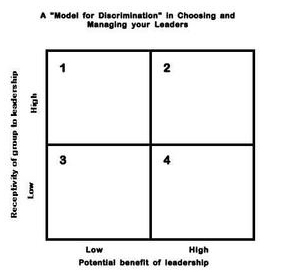The premise for this article is that you do not have the resources to attain perfect leadership for every group in your firm so you have to decide where your biggest return is–and then discriminate in terms of where you put your efforts. Your only hope is to choose effective leaders who can in turn help the various pieces and parts of your firm succeed in the missions that will have the greatest impact on your future.

Black Holes and Bright Lights
Some of the leaders whom you appoint will protest: You don't understand, I must deal with some idiosyncratic and extreme personalities. Many groups have within them individuals that might be referred to as stars. The relevant question is whether these stars are black holes or bright lights.
Bright light stars illuminate those around them. If you think of your favorite sports franchise, you might be able to think of a player who not only has individual star quality but who seems to raise the level of play of the entire team as well. This is a bright light. Conversely, all too many of us can think of a stars who demoralize those around them and operate almost in spite of their team, or group, or firm, rather than in harmony with it. These are black holes.
Black holes, in physics, consume so much energy that even light cannot escape. The gravity is so intense that, at least theoretically, all matter occupies an infinitely small space. The relevance of the black hole or bright light analysis for your stars is to determine how they are to be managed. The bright lights usually do not pose a problem. Unfortunately, this may mean that they are under-managed in favor of the squeaky-wheel black holes.
The issue with black holes is whether they can be neutralized. Some leaders refer to black hole individuals as requiring high maintenance.
Can you and the leaders who serve you afford the time, effort, attention that it takes, not to necessarily enhance the performance of the black hole, but rather to simply neutralize the impact so that he or she does not demoralize the team? To their credit, some black holes are easily neutralized. They simply need to be made aware of their influence, and to be asked by someone whom they respect to refrain from behavior that negatively affects the group. The quid pro quo is usually a certain amount of autonomy for the challenging individual.
There are, unfortunately, other kinds of black holes who seem to be unable to either understand or accede to such requests. These black holes are dangerous in that they will consume the efforts of the leader as well as negatively affect the performance of the group. These individuals are tolerated to the detriment of the group and therefore the firm. They should be isolated from the group as necessary or in extreme cases should be allowed to go and live somewhere else, their books of business notwithstanding.
Action Points
I suggest that you might consider the following action steps.
First, assess each current group and place it into The Discrimination Model. First, list each group in the firm. Using a forced choice method–i.e., you must decide!–rate each group on the receptivity/potential benefits axes that comprise the model. Then place the group in the appropriate quadrant.
The only guidance I can offer is that this is a time for reality, not self deception. So, do the exercise alone. That will help you to be honest with yourself. This is not a committee decision. Earlier I mentioned that you will be judged for the accomplishments of the firm during your reign. It will be of little help to say, I knew what to do but the committee that advised me democratically forced me on the wrong path.
Second, consider the existing leader of the groups that fall into Quadrant 2. In particular, analyze their competencies and weaknesses against the leadership attributes listed below the model.
Third, manage these leaders by requiring of them that they take on assistant leaders to complement them, both in style and approach, and to alleviate their time burdens. If a Quadrant 2 leader is reluctant to accept such an offer of assistance, remove him or her as leader. You have far too much to lose, and too much to gain, to tolerate an uncooperative leader in the all-important Quadrant 2.
Having said that, you may be dismissing someone with informal influence and importance. If that is the case, it may be appropriate to give such individuals honorary roles; for example, making them chairpersons of the group but not its de facto leaders.
Earlier, I alluded to the tendency among lawyers to want to organize the firm as if drafting an agreement, with perfection and consistency, rather than by trusting your instincts. In this vein, a firm's leadership should not be configured like a perfectly coherent legal document. As we've suggested, different leaders should have different roles, depending on the nature of their group. There should always be flexibility for each group situation.
For example, it should be quite tolerable for a firm to have a chairman of one group but a practice group leader of another. Rigid conformity to consistency in titles unnecessarily restricts the discretion of the firm leader.
I hope that the analysis contained in this article will allow you to discriminate in a very positive and constructive manner. By determining where the greatest benefit from leadership might be, as well as where the greatest receptivity to such leadership might lie, you can concentrate your efforts on high-yield leadership appointments by knowing which leaders have the best chance to create success in your firm. You can more carefully select them and then more carefully manage them.
Do you abandon the other leaders? No. You just don't let every proverbially squeaky wheel get your grease. My colleagues and I have often recommended that enlightened firm leaders create a council of leaders who would meet regularly to learn from one another. A small investment of your time on a monthly, or, if necessary, bimonthly, basis–meeting with your leaders for a focused two hours, free of administrative distraction–can do a great deal to elevate the management competence in your firm.
By learning to be less demanding of those leaders who are in a caretaker role, in favor of being far more demanding of the leaders of areas that represent the firm's future prosperity, you will be allocating wisely the most valuable resource of the firm.
That resource happens to be you, and your time and energy as its leader.

Attributes of Constituent Practitioners in the Model
Quadrants 1 and 2 (high potential benefit from leadership): Promising future work and/or practice areas. Highly value work. High hourly rates. Cutting-edge substantive practice areas and/or industries-served. Expertise often requires combined disciplines. Unusual, extraordinary individuals.
Quadrants 3 and 4 (low potential benefit from leadership): Dying practice areas. Routine work. Large proportion of practitioners nearing retirement. Practitioners practice separately, not as team. Clients are in declining industries. Quadrants 1 and 3 (Low receptivity to leadership): Maverick practitioners. Little teamwork. Sole practitioner mentality. Perhaps too valuable to remove from firm, but not the core of the firm's future.
Quadrants 2 and 4 (High receptivity to leadership): Dynamic individuals seeking a direction. Individuals aware of significant potential. Junior members of team requesting help from more experienced. Requirement to share knowledge among members is high.
Required Attributes of Leaders in Model
Quadrant 1 (high potential benefit from leadership; low receptivity to leadership): Leader requires strong interpersonal skills. Seniority. Prestige in practice area. This leader would benefit from leadership skills training to deal with difficult constituents.
Quadrant 2 (high potential benefit from leadership; high receptivity to leadership): These leaders are the firm's most important. These must have skills beyond mere seniority, prestige. These leaders require the ability to enthuse, to envision, and to take on assistant leaders who can attend to detail and continuity. These leaders require most of the firm leader's attention. It is essential that these leaders have leadership skills training.
Quadrant 3 (low potential benefit from leadership; low receptivity to leadership): These leaders require the ability to communicate as a liaison between the group and the firm's management, and to ensure that an adequate level of administration is attended to.
Quadrant 4 (low potential benefit from leadership; high receptivity to leadership): This leader might, above all else, focus on skill development, knowledge-sharing, and the creation of systems. The group is already receptive to leadership, but the objective here is to maintain adequate systems and to prod additional profitability from those systems rather than necessarily create new ones for the future.

